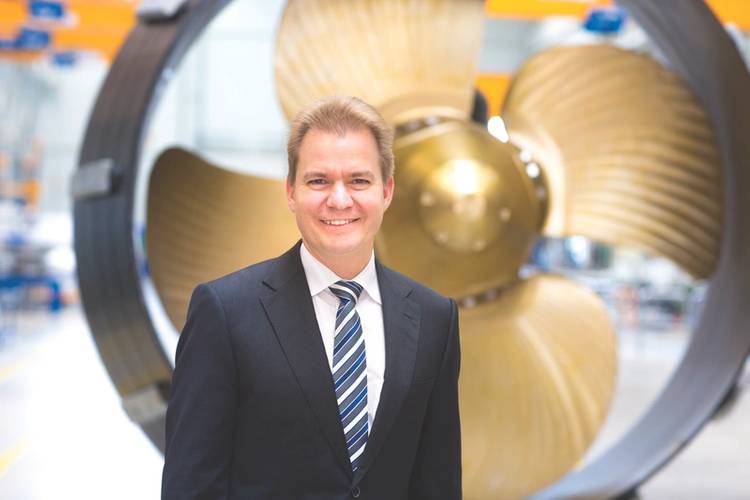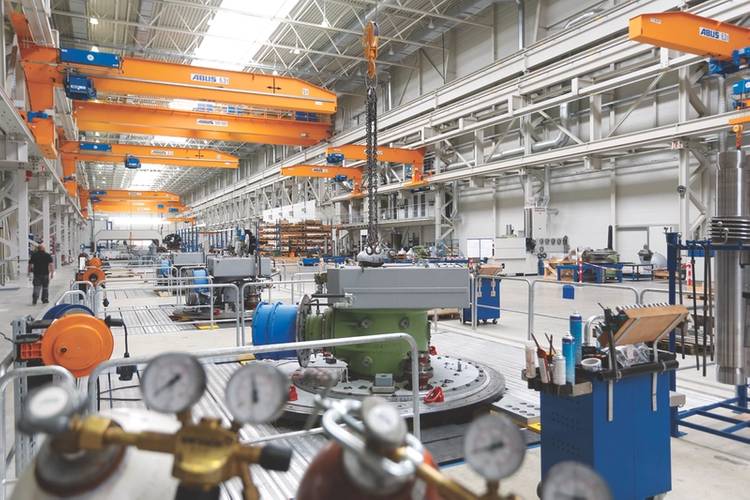Schottel's Strahberger: One Year at the Helm
Schottel's Dr. Christian Strahberger, the energetic new leader for this ubiquitous maritime propulsion brand, discusses the strategy to prepare for the inevitable market rebound.
Schottel, a ubiquitous German-based maritime propulsion company, is firing on all cylinders and preparing now for the inevitable maritime market upturn. The company's new Managing Director, Dr. Christian Strahberger, discusses the strategy.
While the maritime industry endures an overall downturn, quality, long-term companies see opportunity amidst the challenge, using lean times to optimize operations and staff while plotting a course for the inevitable turnaround. This is the case at Schottel, led by its energetic new leader and CEO Dr. Christian Strahberger who joined Schottel in January 2016.
“When you join a new company you have an outside perspective,” said Strahberger. “I think the important perspective is not my vision before I joined, rather building a vision jointly with the management team, and jointly with the employees of the company, so that we have a shared common goal and passion for what we want to achieve. This was the task for the first half year.”
Like many leaders in this industrial sector, Strahberger recognizes that all of the machinery and technology in the world is only as good as the people managing and operating it. To that end he highly values the company’s human assets.
“The greatest strength (of Schottel) are the employees of the company,” said Strahberger. They are focused on the customer, with a shared passion and drive that is in the genetics of Schottel; I will try to keep it this way. I had the luck to find a passionate team, a group that is fun to work with and very dedicated to the company and to the customers,” he continued. “I also had to fill two key positions on the sales and service side, and I think now we have a team with a shared vision and direction for the coming 12 to 18 months.”
‘Down’ is the New ‘Up’
While Strahberger admits that current market conditions are difficult in some sectors, when he looks at the market in overview he sees a marine industry that is fragmented, which makes broad generalizations difficult. “Oil and gas related and exploration are really dreadful at the moment, but there are other parts (of the industry) that are doing well,” said Strahberger. “We see good activity in the tug and the ferry business, we see good activity in some merchant sectors. The business here may not be great, but it is stable and companies keep investing at a moderate level.”
While the tug, ferry and offshore business will always be staples, he sees potential in the megayacht market and inland waterways markets as ripe for growth. Beyond a specific market segment however, he sees opportunity everywhere as the industry evolves from fixed shaft lines to steerable thrusters. “You see this transition taking place in many sectors, and they are about to happen in others. I see this as a big opportunity,” said Strahberger.
Looking internally, he values these market pauses as a point to reflect on his own company’s processes and operations, evaluating every step in the chain from product conception through life-cycle management with the end user. “I believe these down cycles are very important for industry,” said Strahberger. “If you look back in history you will find time and again that big innovations have been started during down cycles. I think it’s important to use this down cycle to re-think what you’re doing and how you’re doing it. Now is the time to adapt to the ‘new norm.’”
‘The new norm’ is a phrase often bandied about when discussion turns to the offshore oil and gas markets, and Strahberger like many others does not foresee energy pricing rising fast or high in the near term. “We have to be agile and adaptive to understand the customer needs for the coming five to 10 years so that the company is better set up to take advantage when the market turns around; this is easier said than done, but that is our goal.”
Never Stop Innovating
Strahberger comes from a technical education and has a clear passion for technology, a passion which he shares by extension with Schottel’s Research & Development department. He believes continued investment in times good and bad is critical to his company’s long-term health. “The current focus is on new products and we are ramping up R&D,” said Strahberger. “This is one of the advantages of being a family owned company and we have a strong backing of the family, committed to the company and the maritime industry. This is an advantage particularly during tough times to continue pushing to innovate and develop in shaping the company with new products and new technologies.”
Schottel is committed to the entire value chain, and to that end it houses complete manufacturing steps in house, from raw steel and machining to assembly and testing, including CFD and in-house design. “This is a core concept to really understanding the product and quality control throughout the chain,:” said Strahberger.
Schottel’s continued investment in this regard is plain to see, as it currently explores new means to help its ship owner clients meet new international emission, safety and environmental regulations.
One such innovation is the Schottel EcoPeller (SRE), a thruster optimized for open sea and coastal operating conditions. The SRE is designed with hydrodynamic insights from CFD simulations and model tests, and it is designed to be a flexible and efficiency propulsor choice available in power ratings between 1,000 and 5,000 kW, in both FPP and CPP variants.
Central to the SRE is another Schottel investment in innovation, namely the HTG high torque gears. HTG is designed as an efficient, robust gearbox with low maintenance requirements. Specifically the HTG enables bevel gears of the same dimensions to transmit up to 15 percent higher drive torque with the same safety margins. For the same drive torque, it is possible to have a more streamlined underwater gearbox housing, helping to increase overall hydrodynamic propulsion efficiency.
Last but certainly not least, in 2015 Schottel commenced operations at a new plant near the company’s headquarters in Germany, and now offers customers a more rugged Rudderpropeller courtesy of an optimized coating process.
The underwater elements of the propulsion unit are coated with several layers of hard, two-component epoxy resin, which according to the company is characterized by 2.3 times greater abrasion resistance and approximately 60% greater adhesion.
Christian Strahberger
Dr. Christian Strahberger took over as the Managing Director of Schottel GmbH in 2016. Strahberger, 42, is an industry expert with a strong technical and intercultural background. After studying in both Germany and the United States to earn his doctorate in Physics, he began working for Siemens AG in 2001 and later for the mechanical engineering company Voith in 2009. While there he held several managerial positions. Most recently, he has been serving as Chairman of the Board of Management for the Marine division of Voith Turbo Schneider Propulsion. He has extensive experience in the area of ship propulsion.
(As published in the December 2016 edition of Maritime Reporter & Engineering News)







